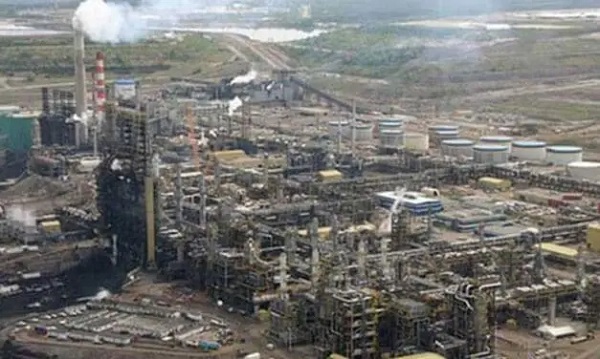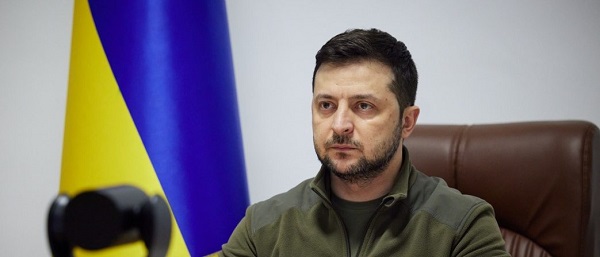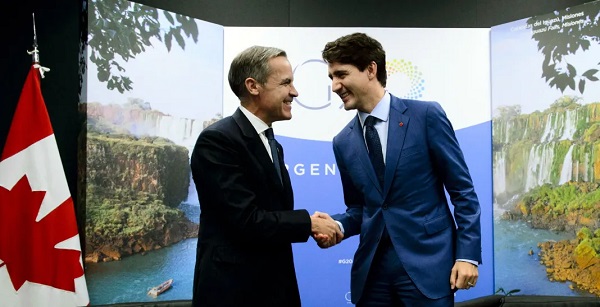Opinion
Biden Promised To Build Half A Million EV Charging Stations. So far, There Are A Grand Total Of 8.

 From the Daily Caller News Foundation
From the Daily Caller News Foundation
The Biden administration has spent tens of billions of dollars on green energy and yet last year the U.S. and the world used record amounts of fossil fuels.
That would seem to be prima facie evidence that this “great transition” to renewable energy has so far been an expensive policy belly flop.
The evidence is everywhere. Americans aren’t buying EVs anymore than they were before Biden was elected. The car companies even with record federal subsidies are losing billions of dollars making EVs that people don’t want. Wind and solar still account for less than 15% of American energy, and across the country hundreds of communities are saying “not in my backyard” to ugly and spacious solar and wind farms. And of course gas prices at the pump and electric bills are 30% to 50% higher, even though we were promised that the green revolution would save us money.
A case in point is the scandalous mismanagement of how these green energy programs are being implemented. Consider the $7.5 billion federal program stuck inside the Biden 2021 Infrastructure bill — a law that Biden touts as one of his great achievements. That bill promised half a million EV charging stations installed all over the country.
Instead, there have been a grand total of… drum roll please…”seven or eight installed.” To be fair, that was through last month. They might be up to nine now.
When Transportation Secretary Pete Buttigieg was confronted recently on CBS’s “Face the Nation” about what happened with all the money, he hemmed and hawed and replied: “In order to do a charger, it’s more than just plunking a small device into the ground, there’s utility work, and this is also, really, a new category of federal investment.”
Uh huh! Sure. Installing an electric charger for a Tesla in your garage is very complicated business. It’s like trying to Build the Taj Mahal (which may not have cost $7.5 billion).
Here’s another mystery. Why can’t Pete give us an exact count on the progress when the number is small enough to use his fingers? What is for sure is that at this pace they may get 500 built by 2030 — not the 500,000 promised.
Thank God our celebrated transportation secretary renowned for riding his bike to his office in Washington wasn’t in charge of the Normandy landing.
Then there is the question of where the $7.5 billion of taxpayer money has actually gone. At their current rate of production the final program’s price tag could inflate to more than $1 trillion.
If Trump were president, he’d have long ago summoned Mayor Pete to the Oval Office and greet him with those two words that made him famous: “YOU’RE FIRED.”
Instead many Democrats are quietly talking about throwing Joe Biden off the ticket and one of the front runners to take his place is none other than the highly accomplished Pete Buttigieg.
But there are some serious lessons to be learned from this monumental screw-up.
First, though Biden loves to chat up how much money the government is “investing” — where are the signs that any of these trillions of dollars of borrowed money have improved our lives. This EV charger scandal is just another reminder that the government generally doesn’t “invest” tax dollars — it mostly wastes them.
Second, competence matters. At the Committee to Unleash Prosperity we released a study finding that more than 90% of the Biden top economic and finance team has NO experience running a business. We have an energy secretary who knows nothing about energy and a transportation secretary who knows nothing about transportation. They are either lawyers, academics, politicians or government employees.
They are not bad people. They just don’t know how to run anything — and it shows.
Finally, why do we need the government to build EV charging stations? One hundred years ago the government didn’t build gas stations. They just magically sprouted up all over the roads that crisscross America because entrepreneurs responded to the demand. So two or three brothers would scrap together some cash, buy a small plot of land on I-66, build a service station with four to eight hoses connected to a tank, put up a tall sign posting the gas price and drivers would pull in and fill er up.
All of this “infrastructure” without a single penny or instruction manual from Washington.
Can you imagine if Biden had been president in the 1920s and proclaimed that the government will build 500,000 gas stations? They still wouldn’t be built and we’d all be waiting in long gas lines.
Stephen Moore is a visiting fellow at the Heritage Foundation and a co-founder of the Committee to Unleash Prosperity.
Alberta
IEA peak-oil reversal gives Alberta long-term leverage

This article supplied by Troy Media.
The peak-oil narrative has collapsed, and the IEA’s U-turn marks a major strategic win for Alberta
After years of confidently predicting that global oil demand was on the verge of collapsing, the International Energy Agency (IEA) has now reversed course—a stunning retreat that shatters the peak-oil narrative and rewrites the outlook for oil-producing regions such as Alberta.
For years, analysts warned that an oil glut was coming. Suddenly, the tide has turned. The Paris-based IEA, the world’s most influential energy forecasting body, is stepping back from its long-held view that peak oil demand is just around the corner.
The IEA reversal is a strategic boost for Alberta and a political complication for Ottawa, which now has to reconcile its climate commitments with a global outlook that no longer supports a rapid decline in fossil fuel use or the doomsday narrative Ottawa has relied on to advance its climate agenda.
Alberta’s economy remains tied to long-term global demand for reliable, conventional energy. The province produces roughly 80 per cent of Canada’s oil and depends on resource revenues to fund a significant share of its provincial budget. The sector also plays a central role in the national economy, supporting hundreds of thousands of jobs and contributing close to 10 per cent of Canada’s GDP when related industries are included.
That reality stands in sharp contrast to Ottawa. Prime Minister Mark Carney has long championed net-zero timelines, ESG frameworks and tighter climate policy, and has repeatedly signalled that expanding long-term oil production is not part of his economic vision. The new IEA outlook bolsters Alberta’s position far more than it aligns with his government’s preferred direction.
Globally, the shift is even clearer. The IEA’s latest World Energy Outlook, released on Nov. 12, makes the reversal unmistakable. Under existing policies and regulations, global demand for oil and natural gas will continue to rise well past this decade and could keep climbing until 2050. Demand reaches 105 million barrels per day in 2035 and 113 million barrels per day in 2050, up from 100 million barrels per day last year, a direct contradiction of years of claims that the world was on the cusp of phasing out fossil fuels.
A key factor is the slowing pace of electric vehicle adoption, driven by weakening policy support outside China and Europe. The IEA now expects the share of electric vehicles in global car sales to plateau after 2035. In many countries, subsidies are being reduced, purchase incentives are ending and charging-infrastructure goals are slipping. Without coercive policy intervention, electric vehicle adoption will not accelerate fast enough to meaningfully cut oil demand.
The IEA’s own outlook now shows it wasn’t merely off in its forecasts; it repeatedly projected that oil demand was in rapid decline, despite evidence to the contrary. Just last year, IEA executive director Fatih Birol told the Financial Times that we were witnessing “the beginning of the end of the fossil fuel era.” The new outlook directly contradicts that claim.
The political landscape also matters. U.S. President Donald Trump’s return to the White House shifted global expectations. The United States withdrew from the Paris Agreement, reversed Biden-era climate measures and embraced an expansion of domestic oil and gas production. As the world’s largest economy and the IEA’s largest contributor, the U.S. carries significant weight, and other countries, including Canada and the United Kingdom, have taken steps to shore up energy security by keeping existing fossil-fuel capacity online while navigating their longer-term transition plans.
The IEA also warns that the world is likely to miss its goal of limiting temperature increases to 1.5 °C over pre-industrial levels. During the Biden years, the IAE maintained that reaching net-zero by mid-century required ending investment in new oil, gas and coal projects. That stance has now faded. Its updated position concedes that demand will not fall quickly enough to meet those targets.
Investment banks are also adjusting. A Bloomberg report citing Goldman Sachs analysts projects global oil demand could rise to 113 million barrels per day by 2040, compared with 103.5 million barrels per day in 2024, Irina Slav wrote for Oilprice.com. Goldman cites slow progress on net-zero policies, infrastructure challenges for wind and solar and weaker electric vehicle adoption.
“We do not assume major breakthroughs in low-carbon technology,” Sachs’ analysts wrote. “Even for peaking road oil demand, we expect a long plateau after 2030.” That implies a stable, not shrinking, market for oil.
OPEC, long insisting that peak demand is nowhere in sight, feels vindicated. “We hope … we have passed the peak in the misguided notion of ‘peak oil’,” the organization said last Wednesday after the outlook’s release.
Oil is set to remain at the centre of global energy demand for years to come, and for Alberta, Canada’s energy capital, the IEA’s course correction offers renewed certainty in a world that had been prematurely writing off its future.
Toronto-based Rashid Husain Syed is a highly regarded analyst specializing in energy and politics, particularly in the Middle East. In addition to his contributions to local and international newspapers, Rashid frequently lends his expertise as a speaker at global conferences. Organizations such as the Department of Energy in Washington and the International Energy Agency in Paris have sought his insights on global energy matters.
Troy Media empowers Canadian community news outlets by providing independent, insightful analysis and commentary. Our mission is to support local media in helping Canadians stay informed and engaged by delivering reliable content that strengthens community connections and deepens understanding across the country.
Daily Caller
Zelenskyy Under Siege As Top Aide Resigns After Home Raided In Major Corruption Scandal


From the Daily Caller News Foundation
Ukrainian President Volodymyr Zelenskyy’s chief of staff, Andriy Yermak, resigned Friday after his home was raided in an ongoing corruption probe that threatens to undermine Zelenskyy’s grip on power during wartime.
Ukrainian authorities on Friday raided the home of Andriy Yermak, Zelenskyy’s chief of staff and right-hand man, as part of a sweeping corruption probe investigating Zelenskyy’s possible involvement in a $100 million scheme to defraud the nation’s atomic energy company. Yermak’s resignation comes at a time when Zelenskyy is under increasing pressure to accept a U.S.-brokered peace deal to end Ukraine’s war with Russia.
The investigation has shaken Ukrainian confidence in Zelenskyy’s administration while Russian strikes continue to rock critical infrastructure. So far, Russia has not commented on the new proposed peace deal.
As a nonprofit, we are dependent on the generosity of our readers.
Please consider making a small donation of any amount here.
Thank you!
Zelenskyy first rose to power on an anti-corruption platform in the 2019 elections, which propelled him into the international spotlight. He has enjoyed a positive global reputation during the three-year war with Russia and has been hailed by numerous Western leaders as a beacon of democracy against autocratic Russia.
Zelenskyy has so far worked with the U.S. on the proposed peace agreement, but has also expressed major reservations about what it will mean for his country. In a public address on November 21, Zelenskyy said the plan puts Ukraine in the position of “either losing its dignity or the risk of losing a key partner.”
Despite the prospect of losing U.S. intelligence sharing and weapons if Ukraine doesn’t accept the deal, Zelenskyy has been shoring up European alliances and international support, most recently signing a deal with France to obtain 100 Rafale jets for its air force. The deal also included anti-air equipment, drones and other munitions.
The Ukrainian Ministry of Foreign Affairs did not immediately respond to the Daily Caller News Foundation’s request for comment.
-

 Alberta5 hours ago
Alberta5 hours agoFrom Underdog to Top Broodmare
-

 International1 day ago
International1 day agoAfghan Ex–CIA Partner Accused in D.C. National Guard Ambush
-

 Energy1 day ago
Energy1 day agoPoilievre says West Coast Pipeline MOU is no guarantee
-

 Banks2 days ago
Banks2 days agoFrom Energy Superpower to Financial Blacklist: The Bill Designed to Kill Canada’s Fossil Fuel Sector
-

 International2 days ago
International2 days agoTrump orders 500 more troops to reinforce D.C. after Guard shooting
-

 Artificial Intelligence2 days ago
Artificial Intelligence2 days agoTrump’s New AI Focused ‘Manhattan Project’ Adds Pressure To Grid
-

 armed forces2 days ago
armed forces2 days agoCarney’s ‘Shared Sacrifice’ Is a Lie. Only Veterans Are Bleeding for This Budget
-

 Alberta1 day ago
Alberta1 day agoAlberta and Ottawa ink landmark energy agreement









